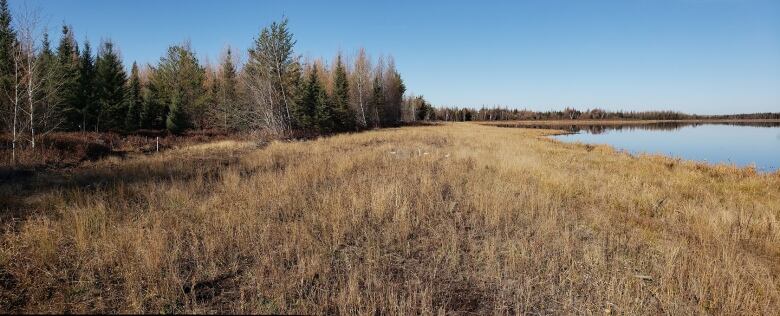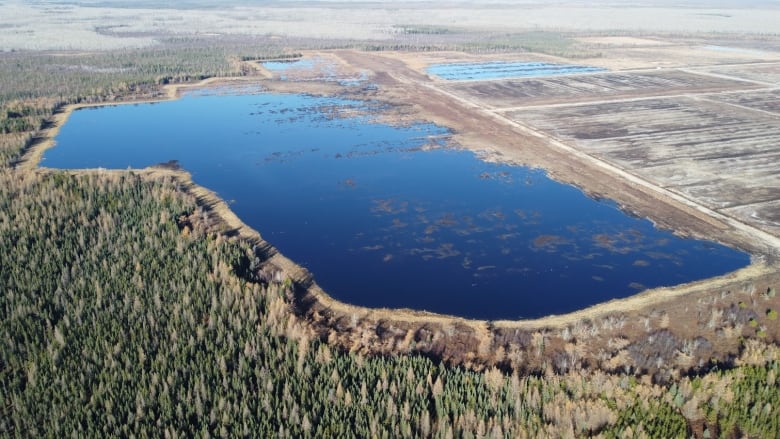How peatlands on the Prairies are at risk from climate change
Peatlands cover around 3% of the global land mass, but store 30% of soil carbon

The Prairies Climate Change Project is a joint initiative between CBC Edmonton and CBC Saskatchewan that focuses on weather and our changing climate. Meteorologist Christy Climenhaga brings her expert voice to the conversation to help explain weather phenomena and climate change and how they impact everyday life.
As we work to curb greenhouse gas emissions, a part of that picture is how much carbon dioxide is absorbed by the landscape.
Carbon is taken in by plants, old growth forests, even the stretches of grasslands that dominate the prairies.
But there is another natural ecosystem that is less picturesque, but critical to the carbon cycle.
We're talking about peatland. It may look like nothing more than swamps, or bogs — a wet and mushy mess of partially decomposed plants that have accumulated for thousands of years.
But it's important not only for the ecosystem it provides for plants and animals, but because of what lies below the surface — carbon.
"They are challenging environments, but they've never been valued for their biodiversity, for their carbon," said Lorna Harris, an ecosystem scientist and forest, peatlands and climate change program lead for the Wildlife Conservation Society of Canada.
Peatlands cover around three per cent of the global land mass, but store 30 per cent of the world's total soil carbon — or carbon stored by dead plants, insects and other organic materials beneath the surface.
Canada is home to a quarter of the world's peatland — we often call it muskeg. It covers around 1.1 million square kilometres, and spans every province and territory.

"Peatlands are one of the world's largest terrestrial carbon stores because they've been taking in carbon for thousands and thousands of years and storing it there," said Harris.
"They are hugely important carbon stores. They're also active carbon sinks across most of Canada."
Carbon sinks remove carbon from the atmosphere, a critical process to curb greenhouse gas emissions.
But our peatlands have not remained intact.
So what is happening in our peatlands and what does that mean for all of that carbon?
Using and losing
Peatlands are at risk, often because of value seen beyond the wet surface.
Peatlands are degraded, drained, burned, excavated for mining or road construction, extracted and converted to agriculture according to Harris and there are few policy safeguards to protect them.
Without water, all the plant matter begins to decay and carbon is released to the atmosphere.

"So much carbon is released from these ecosystems. It's quite shocking."
Ontario has the largest peatland area in the country, but there is a sizable region in the prairies.
In Alberta, peatland covers close to 92,000 square kilometres and stores 19.9 billion tonnes of carbon. Saskatchewan has around 60,000 square kilometres storing 7.3 billion tonnes, according to Harris.
"In Alberta there's been quite large areas of peatland destroyed for oil and gas," she said.
Risks as our climate changes
Natural peatlands are relatively resilient, but once disturbed they are more vulnerable to the continued effects of climate change, especially in Western Canada.
"Alberta peatlands have got quite a lot of pressure on them from the development here, and also because it's a drier climate here in western Canada, they are likely to be under significant pressure with climate warming," said Harris.
One of the major risks comes from the increased prevalence of wildfire in a warmer world.

Fire will increase carbon loss from the peat, but also plays a factor in peatlands that are present in permafrost areas.
Harris said she has worked in permafrost peatlands that were affected by fire. The regions experienced more rapid permafrost thawing in the years that followed the fires.
"So you get the carbon loss from the fire and you get the carbon lost from the permafrost thaw and then a more rapid change in the land cover."
Restoring what's lost
The good news for our peatlands is that it is one of our damaged landscapes that can be restored.
Harris says that avoiding conversion of more peatland is key but restoration is also important for areas that have already been degraded.
Restoration does not replace the thousands of years of stored carbon, but it can return peatlands from a carbon source back to a carbon sink.
"If we don't restore that ecosystem to at least make it carbon neutral and ideally make it a carbon sink again, it is a source of greenhouse gas emissions to the atmosphere," said Harris.
And successful restoration is happening in Canada, especially with regards to peatlands lost to horticulture extraction – peat that is removed for use in things like fertilizers.
"The most popular [restoration technique] in Canada, which is also picked up kind of globally for restoring these peatlands that have been extracted for horticultural peat, is called the moss layer transfer technique and it was developed out of Quebec," said Pete Whittington, an associate professor at Brandon University in Manitoba, who has been working in peat restoration.

During that process, the extracted peatlands are flattened to prevent water runoff, and vegetation is transplanted from a nearby natural peatland.
The restored site is then covered with straw mulch to retain moisture, fertilized and allowed to regrow.
"It's about a 10-to-1 ratio, so they can use one hectare of natural peatland to restore 10 hectares of extracted peatland," said Whittington.
That restoration can happen within a month, and once completed, rain and snow will take over, restoring the vegetation.
Peat bogs, or peatlands that are kept wet by precipitation only, can see the moss establish within three to five years after restoration, according to Whittington.
Within 10 to 20 years, that restored land will return to a carbon sink, taking in more carbon than is released to the atmosphere as you would see with a natural peatland.
"It kind of looks like a peatland, acts like a peatland within 10 to 15 years."
Whittington's current research is for drain peat fens, or peatlands fed by groundwater, bogs, and streams, which are more complicated.
A team of scientists is testing modifications to the moss layer transfer technique to a fen near Winnipeg, to see what type of restoration is the most effective, especially in drier climates that we see on the Prairies.
According to Whittington, spending the extra time and energy to do the restoration correctly is crucial for maintaining the ecosystem as a carbon sink.
"If you just go in and block the drainage ditches and rewet [peatlands] they continue to be a net source of atmospheric carbon dioxide for their lifetime," he said.
Our planet is changing. So is our journalism. This story is part of a CBC News initiative entitled "Our Changing Planet" to show and explain the effects of climate change. Keep up with the latest news on our Climate and Environment page.


